- OBVERSE
- The face, or more important side, of a flag; and in the Western tradition
always depicted with the hoist to the observers left - the dexter in heraldry (see also
'double-sided' and
'two-sided'.
Please note however, that in Arabic tradition the
flag is generally depicted with the hoist to the observers right the sinister
in heraldry (see also sinister;
dexter,
reverse and
sinister hoist).
- OCCASIONAL FLAG
- See commemorative flag.
- OFF-CENTRED
- A term used to describe the vertical or horizontal arm of a cross that is
not set on a flags vertical or horizontal meridian see off-centred cross 2) below
(also centred
and off-set towards).
- OFF-CENTRED CROSS
- 1) Generically see Scandinavian Cross.
- 2) Specifically, a cross of the Scandinavian-type that is used on a flag
which is not from, or has no connection with that region, or whose vertical
arm may or may not be centred but whose
horizontal arm is closer to the top or bottom of the flag.



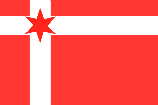

From left: Hong Kong Christians (fotw); Volyinia,, Ukraine (fotw); Thunstetten, Switzerland (fotw));
Flag of Vνdeς, Czech Republic (fotw); Flag of Zdechovice; Czech Republic (fotw)
- OFF-SET (or OFFSET) TOWARDS
- The term used to describe a charge (or charges) or a stripe (or stripes) that is (or are) set
towards the hoist, fly, top or base of a flag, rather than lying on its vertical or horizontal meridian
shifted towards (see also centred,
(see also charge,
inset,
meridian and
off-centred and
optical proportions).
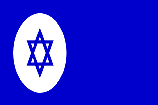
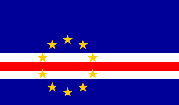
Civil Ensign of Israel (fotw); National Flag of the Cape Verde Islands (fotw)
Please note that this term should always be accompanied by a further description,
for example, off-set towards the hoist.
- OFFICERS FLAGS
- In US usage and some others, those flags that are flown by the past and present
officers of a club, especially of a yacht or boating club yacht officers flags
(but see also broad pennant 2)).
![[yacht commodore]](../images/v/vxt-d574.gif)
![[yacht vice commodore]](../images/v/vxt-d574a.gif)
![[yacht rear commodore]](../images/v/vxt-d574b.gif)
![[acht past commodore]](../images/v/vxt-d574c.gif)
From left: Yacht Commodore, US (fotw); Yacht Vice Commodore,
US (fotw); Yacht Rear Commodore, US (fotw); Yacht Past Commodore, US (fotw)
- OFFICIAL FLAG
- 1) A flag that has been formally adopted by the relevant authority, and/or is considered by them to
represent a particular entity, institution or cause, as opposed a design or type which is not so authorized
(see also flag law,
folk flag,
institutional flags (official),
institutional flags (unofficial) and
type flag).
- 2) A term that may be employed to describe a sub-national flag which is specifically for official rather
then general civil use (see also banner 4),
civil flag,
ceremonial flag 1),
state service flag and
sub-national flag with following notes).
- OGIVAL
- The term for a form of flag (now obsolete), or of a gonfanon, where the
fly is rounded and comes to a point boat-tailed or shield-shaped but see
lanceolate (also
engrailed fly,
gonfalon 1),
and shield).
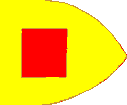

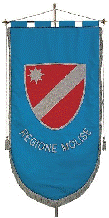
Flag of Persia c1350? (fotw); Flag of Grenada, Spain c1350 (Klaus-Michael Schneider); Gonfanon of Molise, Italy (official website)
Please note that the differences between ogival and lanceolate are
often very slight, and we suggest that both entries be consulted.
- OLD GLORY
- 1) Generally a poetic nickname for the US national flag the Stars and Stripes (see
also Betsy Ross flag,
continental colours,
Franklin flag,
quincunx,
star-spangled banner and
stars and stripes).
- 2) Specifically referring to a US national flag bearing 34 stars and a small white anchor,
reputedly belonging to a Captain William Driver.

Captain Drivers Flag (fotw)
- ONE-AND-A-HALF ARMED CROSS
- The term used in Eastern European heraldry and a direct translation of the Polish Pσltora krzyz that
describes a Latin cross which has a second horizontal arm projecting on one side only - usually the sinister
(see also cross 2),
cross of Lorraine,
Latin cross in appendix VIII and
two-and-a-half armed cross).

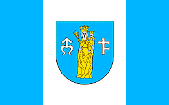

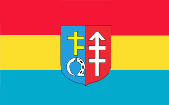

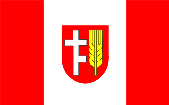
Arms and Flag of Nowy Targ, Poland (fotw); Arms and Flag of Siemiatycze. Poland (fotw);
Arms and Flag of Kobylin-Borzymy, Poland (fotw)
- ONOMAST
- See name pennant.
- OPTICAL PROPORTIONS
- A term used when the relative dimensions of a series of stripes progressively
widen between the hoist and the fly in order to appear even when the flag is flying
- graduated stripes -or where a charge is set slightly towards the hoist so that it appears to be centred
under the same circumstances two examples would be the national flag of France for
use at sea, and the federal service flag of Germany (see also
charge 1),
hoist,
fly,
off-set towards,
proportions 2),
stripe and
visual centre).


National Ensign of France (fotw); Federal Service Flag of Germany (fotw)
- OR
- A heraldic term for the metal gold, generally (but not invariably) shown as
yellow in flags, or sometimes as gold leaf or metallic paint, or in an embroidered
design, as gold thread (see also Appendix III
and rule of tincture).
- ORARIUM
- See 'banderole 2)'.
- ORDINARY
- A heraldic term used to describe a simple charge on a shield or banner of
arms. The honourable (or main) ordinaries are said to be the chief, cross, pale,
saltire, fess, pile, chevron, quarter and bend, and whilst these terms are briefly
described separately herein, it is suggested that a suitable glossary or dictionary
of heraldry be consulted for full or further details.
- ORGANIZATIONAL COLOUR (or COLOR)
- See colour 2) and
colours 2).
- ORGANIZATIONAL FLAG
- 1) Generically, the flag of a non-profit making organization of national rather
than international significance, or of the national/district branch of an international
entity, for example the UK National Trust or the Boy Scouts of America (see also
international flag 1)).
- 2) Specifically, in US army usage see
parade flag 2) (also colour 2)
and colours 2).
![[National Trust, UK]](../images/v/vxt-d575.gif)
![[Boy Scouts of America]](../images/v/vxt-d575a.gif)
From left: The National Trust, UK (Bartram); The Boy Scouts of
America, US (fotw)
- ORIFLAMME
- The gonfanon of St Denis, the war flag of medieval France and reputedly adapted
from that of Charlemagne. The exact design is uncertain and has been variously
described; however, it was almost certainly of red silk, possibly triple-tailed
and charged with a number of gold disks surrounded by red roses outlined in blue
the auriflamma (see also gonfanon).
![[Oriflamme interpretation]](../images/v/vxt-d229.gif)
One interpretation of the Oriflamme (CS)
- ORIGINAL FLAG
- See type flag.
- ORLE (or ORLED)
- 1) The heraldic term for a border that is inset from, and parallel to, the edges of a shield, banner
of arms or flag, and which may consist of an unbroken line or be made up by a number of separate charges
for example an orle of plates as illustrated below but see inset border
(also border, charge,
inset and
double-tressure).
- 2) See garland 1).
- 3) The heraldic term that also covers a series of charges in a circular (or near circular) pattern
inset from the edges of a shield, banner of arms or flag, for example an orle of
mullets and the European Union flag as illustrated below.

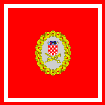
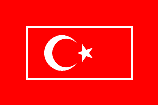

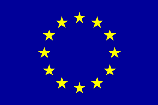
From left: Example; Rank Flag of a General Officer, Croatia (fotw), Flag of The Customs Administration, Turkey (fotw);
Example; Flag of the European Union (fotw)
Please note with regard to 1) that some heraldic writers would consider the inset
narrow border on the Turkish flag illustrated above as a tressure.
- ORTHODOX CROSS
- A term that describes a cross with three horizontal arms but whose lowest horizontal arm is canted, and considered to
be representative of the Eastern Orthodox Churches a triple-armed or triple cross (see also
cross 2),
cross of Lorraine,
papal cross and
two and a half armed cross).


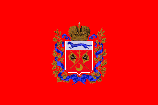
Example; Arms and Flag of Orenburg, Russia (fotw)
- ORTHOGONAL
- 1) (Adj) Generically a term meaning rectangular or pertaining to or involving right angles.
- 2) (Adj) In vexillology a term which may be used when the arms of a saltire or objects placed per
saltire - are set at right angles to each other (particularly when the flag upon which it
or they - appear is rectangular rather than square) (see also
per saltire and
saltire
- 3) (Adj) In vexillology the term may also be used when the fork in the fly of a swallow-tailed
flag forms a right angle at the crutch (see also crutch, and
and swallow-tail(ed)).
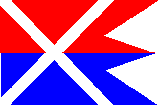
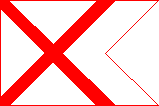
Flag of Nonince, Slovakia (fotw); House Flag of the British India Steam Navigation Co, UK (CS)
- OUTER EDGE
- A term that may be used in describing the edge of a hanging flag that is closest to the truck, and equivalent
to the top edge of a conventionally hoisted flag (see also hanging flag
and inner edge).
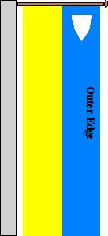
Please note that this term has been introduced by the Editors as no established
alternative could be found.
- OUTRIGGER FLAG
- In German speaking, Central European and some other usage, the term
and a direct translation of the German auslegerflagge - which covers a
long vertically orientated (often but by no means invariably) commercial flag that is
fixed both along its hoist to the flagpole and along
the top edge to a horizontal arm - but see also
framed flag 1) (also
banner 2),
hanging flag and
vertically hoisted flag).
Please note that this type of flag is also a framed flag,
that the term used here is a direct translation of the German auslegerflagge,
and should not be confused with a flag hung from an outrigger pole.
- OUTRIGGER POLE
- The term for a flagpole that projects from the side of a building at an upward
angle, usually equipped with a halyard but is sometimes removable and fitted with
clips to attach the flag directly (see also halyard
and tangle rod).
- OVERALL (or OVER ALL)
- 1) On flags, a term used when a charge (generally but not exclusively reaching the
edges of the flag) is placed over another design, as in for example, the bend on the
Artigas flag of Uruguay (see also charge).
- 2) In heraldry, the term can be used when a charge is placed over other charges,
or over a parti-coloured field, or when an inescutcheon or cartouche is placed over four or more quarters
surtout but see surmounted, by (also
escutcheon,
cartouche 1),
debruised,
inescutcheon and
quarter).

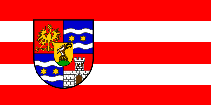

From left: The Artigas Flag, Uruguay (fotw); Shield (CS): Flag and Arms of
Varazdin, Croatia (fotw)
Please note with regard
to 2), it is suggested that a glossary or dictionary or heraldry be consulted
with regard to comparative use of the terms overall and surmounted by.
- OWNER ABSENT FLAG
- In US usage the practice, almost certainly obsolete, of flying a plain blue flag
from the starboard yardarm (or spreader) of a pleasure vessel when the owner is absent
an absence pennant (see also
dinner flag,
guest on board flag,
meal pennant and
yardarm).

Owner Absent Flag, US (fotw)







![[yacht commodore]](../images/v/vxt-d574.gif)
![[yacht vice commodore]](../images/v/vxt-d574a.gif)
![[yacht rear commodore]](../images/v/vxt-d574b.gif)
![[acht past commodore]](../images/v/vxt-d574c.gif)











![[National Trust, UK]](../images/v/vxt-d575.gif)
![[Boy Scouts of America]](../images/v/vxt-d575a.gif)















![[Oriflamme interpretation]](../images/v/vxt-d229.gif)

